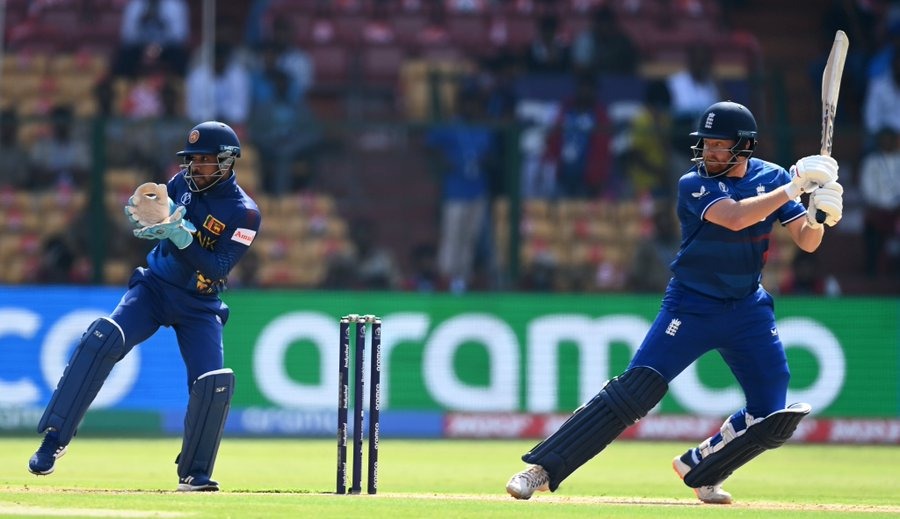Bharath Ramaraj at the Chinnaswamy Stadium, Bengaluru
It was an Under-19 World Cup game between India and England. India, who have an enviable record at the junior level, were expected to emerge victorious. For a while, it seemed that way. England lost one wicket after another, and there seemed to be no way out of the abyss. But each time a wicket fell, one young all-rounder kept clearing the boundary ropes. He cracked an imposing 88-ball 100 and played a pivotal role in one of England’s rare wins over India in Under-19 World Cups. His name was Benjamin Andrew Stokes, and he would go on to become England’s talisman when they won the World Cup on home soil in 2019.
Some 13 years later, as England found themselves in what seemed like an inescapable morass against Sri Lanka, Stokes was the lone man standing amid the ruins around him. On a slightly two-paced deck, if there was one cricketer who could drag England back to safety, then it had to be Stokes. But it wasn’t going to be his day. On 43, Stokes cleared his front leg and cracked a hybrid pull straight into the hands of the fielder at midwicket.
With England seven down, there was no need for that kind of premeditation. But when even your best player’s shot selection malfunctions, then the team has nowhere to go. Just delve deeper into some of the other dismissals from the game. David Malan tamely steered a cross-seam wobbler to the wicketkeeper. Joe Root ran himself out. Jos Buttler once again wafted at a delivery just outside the off stump. Moeen Ali and Liam Livingstone didn’t do any better. And then there was a bizarre dismissal, for which no explanation can be given.
Maheesh Theekshana, the Sri Lankan spinner, bowled a wide down the leg side. Up until that point, everything seemed sane. Adil Rashid, the non-striker, however, had wandered out of the crease. Kusal Mendis, the wicketkeeper, duly spotted it and effected a direct hit, with Rashid finding himself short of the crease. The ninth wicket in England’s innings basically summed up the side’s pitiful performance in the World Cup so far.
The results don’t lie either. England lost by nine wickets to New Zealand, hurtled to a humongous 229-run defeat at the Wankhede against South Africa, were upset by Afghanistan and have now slipped to an eight-wicket loss against fellow stragglers Sri Lanka. The above descriptions of England’s batting woes are obvious facts. But is there more to England’s sorry campaign? Let’s peel away the outside polish to unearth more detail.
England have played 42 ODIs since the 2019 World Cup, and as many as 44 players were used in those matches. Compare that with their 2015-2019 cycle, where they played 88 matches and employed only 34 players. Incidentally, after playing an ODI in March 2023, England next played a 50-over game after a gap of around five-six months.
It is true that the management had a tough time managing the workload due to the Covid-19 situation and bio-secure environments. With England playing more Test matches when compared to other countries and tours getting rescheduled, the selectors couldn’t pick several established stars for some of the ODI rubbers.
A case in point would be England’s Test tour of New Zealand this year – February 8 to February 28 – almost clashing with the limited-overs rubber in Bangladesh – March 1 to 14. As Matthew Mott, England coach, said at a press conference during the World Cup: “It would have been nice to have a proper run-in.”
Just for a moment, if you revisit the England-Sri Lanka game, it could be observed that the England players were uncertain of whether to shift to top gear or try to farm the strike with the goal of resurrecting the innings. This is a far cry from the Eoin Morgan-led England side that played with clarity of thought.
Somewhere, it indicates that England’s white-ball players have lost touch with the 50-over format. It has a slightly different batting tempo in comparison to the shortest format.
In that backdrop, England giving secondary status to their domestic 50-over competition is a point that gains significance. Paul Farbrace, England’s former assistant coach, doesn’t agree, however, with a former ward’s views. “I don’t agree with Root, he normally talks a lot of sense but between 2015 to 2019, the England players weren’t playing much domestic cricket either and were very successful,” he told BBC Five Live. “The T20 Blast is the lifeblood of the counties that play a massive part in English cricket.”
There is also a theory that England haven’t adapted to the different conditions in India. The counter-narrative would be that England slipped to defeats on flat pitches in Ahmedabad and Mumbai. Yes, it did nip around for 8-10 overs in Mumbai, but after that period the conditions were good for batting. And that leaves only the Delhi track, where the ball stayed lower than expected.
Having said all that, England could have batted first in places like Delhi and Mumbai. Even Aiden Markram, the South Africa skipper, observed that he was a bit surprised that England decided to bowl at the Wankhede. And he was quite happy that his bowlers didn’t get ‘cooked’ in rather extreme conditions. There is also a feeling that a proven performer like Jason Roy could have made a difference, but this is a collective failure from England. One player is unlikely to have lifted England out of the mire.
It isn’t just batting, as England’s bowling unit too has come under a lot of scrutiny. Reece Topley was the only bowler who seemed to have the weaponry to succeed on flat tracks. Unfortunately, he once again picked up an injury and was ruled out of the tournament. Mark Wood, the World Cup’s fastest bowler, struggled for control in some of the earlier games.
Wood’s hit-the-deck skills were on show in the four-over spell he bowled against Sri Lanka, and he was perhaps unlucky not to pick up a wicket or two in that spell. But his performances with the ball have largely been well below par. Sam Curran and Chris Woakes, the two all-rounders, have also been taken for runs. Rashid has bowled a couple of gritty spells, but England needed more from their experienced spinner.
England still have a very slim chance of entering the last four. But the harsh reality is that this could end up as England’s worst campaign in the history of 50-over World Cups. England’s flop show could also go down into history books as the worst World Cup title defence. Only a victory or two against a couple of top teams, starting with India on Sunday, could act as balm for their misery.
As Buttler said in the presentation ceremony: “The biggest thing is personal pride. The standards we set for ourselves. Rest of the matches, we want to get back to playing good cricket. Whatever will be will be.”
Over the last eight years, England have tasted more than enough success in the shorter formats. They entered this tournament as the reigning 50-over and T20-over Champions. Perhaps the team doesn’t have the hunger to win more world events and is now at the fag end of a glorious white-ball cycle. It is time for the selectors to usher in fresh blood. A few retirements could be on the way.





